Hare Krsna devotees make a rare visit to sites in Bangladesh connected with Lord Caitanya's movement.
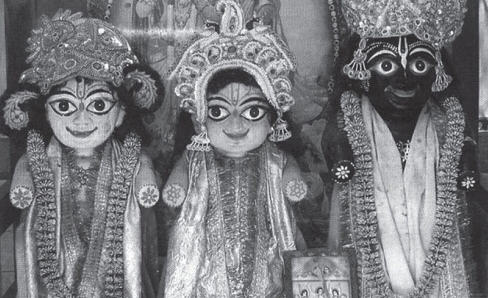
The Bangladesh ambassador had just approved my visa to enter his country. As I got up to leave, he took a photo guidebook from his desk, quickly signed it, and gave it to me with a handshake.
It read: "To Mr. Tibbitts with love. May you find the happiness you're looking for in our beautiful Bangladesh. Mohammed IIah."
I had no doubt I would find happiness in Bangladesh, but it would be of a specific nature. The former Indian State of East Bengal (known as East Pakistan after the partition of India by the British in 1947) became the sovereign state of Bangladesh in 1972 after a war for independence. Being part of India's rich spiritual past, it contains many holy places especially dear to the followers of Lord Caitanya. Numerous devotees of Lord Caitanya were born there, and the Lord Himself performed many divine pastimes throughout Bangladesh's towns and villages. The capital, Dhaka, was a favourite place of Srila Bhaktisiddhanta Sarasvati in the 1930s. He once called Dhaka a second Vrndavana because it contains more than seven hundred Radha- Krsna temples.
I would be travelling to these holy places with a dear Godbrother, Radhanatha Swami. Months ago, we had met in our travels and discovered that we shared an attraction to the pastimes and songs of Srila Narottama dasa Thakura, one of the principal acaryas in our Gaudiya Vaisnava line. He appeared after Lord Caitanya's departure from this world. For years we had longed to visit his birthplace, Kheturi, in Bangladesh. I would be meeting Radhanatha Swami and several of his disciples in Dhaka the next day.
HELP AT IMMIGRATION
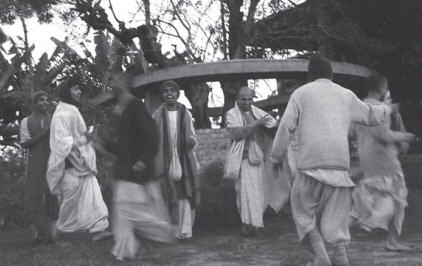
At the Dhaka airport I handed the immigration officer my passport and a form all passengers had to complete with their personal details. I was in Western clothes, as Hindus make up only ten percent of the population and there is sometimes tension between them and the majority Muslims.
After studying the form for a moment, the officer looked up and said, "You wrote that you'll be staying in a hotel, but you didn't mention which hotel. You have to tell me which hotel or I can't let you in."
I had no idea of the name of any hotel in Dhaka. I stood there for a moment, and then the officer motioned me to a nearby room. Suddenly, an Indian man l stepped forward and rebuked the officer.
"For goodness sake, man, he's a tourist. How is he supposed to know which hotels we have here? Foreigners don't come here often, and when they do we can't treat them like this. Let him through!"
Somehow his words worked, and the officer stamped my passport. As I collected my baggage, the Indian man walked by and whispered softly, "Hare Krsna. Have a good trip."
Outside the terminal I met Radhanatha Swami and twelve brahmacaris from his temple in Mumbai, all in Western dress. We ate and then sat in a nearby field to discuss our itinerary. We had only ten days and had to select which holy sites to visit. We decided to begin our journey at the birthplace of Rupa Gosvami and Sanatana Gosvami in Jessore, in the southwest of the country. Our guide, Caru Candra Dasa, ISKCON's regional secretary for Bangladesh, quickly bought our tickets, and two hours later we were on our way.
THE PLACE OF HARIDASA
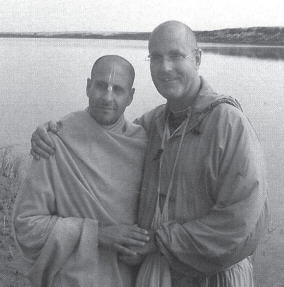
Indradyumna Swami With Radhanath Maharaj
On Radhanatha Swami's suggestion, from the Jessore airport we took a taxi to Benapole, a small village in the jungle where Haridasa Thakura had awakened a prostitute to Krsna consciousness. It was dark when we arrived, but Haridasa Thakura's room was still open. I almost ran to it. Falling down before his image, I prayed for his mercy. As I studied the altar, I was curious to see the deity of a shaven headed woman in a white sari.
"That's Laksahira," Radhanatha Swami said, "the prostitute sent by a government official to seduce Haridasa Thakura. Soldiers hiding in the foliage were supposed to catch them in union and arrest and defame Haridasa. But after listening to Haridasa's chanting of the holy names for three days, Laksahira became purified and took shelter of him. He initiated her, and she became a great devotee."
I prayed for the mercy of Haridasa Tha:kura and Laksahira.
The next day we went to the birthplace of Rupa and Sanatana outside Jessore. Like most of the other holy places we would visit, there wasn't much tosee. After partition, the minority Hindus were persecuted and many of their temples destroyed. The policy continued after the founding of Bangladesh . So, wherever we would go, all that would be left of most holy places was one or two reminders of the divine pastimes that took place there. This was particularly true at the home of Rupa and Sanatana. There was nothing but a single tree. But when we learned it was the very tree under wh ich the Gosvamis performed daily worship, we nestled under it and chanted for several hours.
Often a holy place is built up with many shrines and temples to attract pilgrims and impress upon them its importance, but here we had only a Single tree on which to focus. As we chanted in the simple jungle environment, I thought that one day it too might become a renowned holy place. For the moment it remains hidden from the world, retaining a charm rich in Gaudiya history and saturated with mercy. As the hours passed, I closed my eyes and absorbed myself in the holy names at the spot where Rupa and Sanatana chanted the very same names.
Our next destination was ISKCON's large temple a few kilometers away. As we drove there I asked Caru Candra why the temple had not been built at the auspicious site we had just visited. He replied that the local Muslim authorities would not sell it to us, so ISKCON accepted an offer from a Hindu organization that owned land nearby. It proved to be a better arrangement, because the ISKCON land is situated in the center of 96 Hindu villages. When the beautiful temple was opened in 1999 after years of construction, more than one million people from all over the country attended.
NAROTTAMA, RESERVOIR OF LOVE
Two days later, we new to Rajshahi in the northwest, a shore distance from Kheturi on the banks of the Padmavati River. As our car rumbled along the dirt roads leading to the isolated village, my heart beat in anticipation. I prayed we'd find more than a single tree. I wasn't disappointed. Though Kheturi consists of only forty families (thirey-eight Muslim and two Hindu), we were happy to discover a small, walled temple compound just outside the village.
One of Narottama dasa Thakura's major contributions was organizing at Kheturi the inaugural Gaura Purnima festival, the yearly observance of Lord Caitanya's appearance. Many important Vaisnavas of the time attended, including Lord Nityananda's wife, Jahnava Mata. At that historic event, Narottama dasa Thakura installed six deities: five Krsna deities and one pure gold Lord Caitanya deity. The six Vaisnava devotees currently living at the lakeside temple, built by a pious Hindu businessman more than a hundred years ago, told us that Jahnava Mata collected water from the lake for cooking for the Kheturi festival, and to this day the water is used only for cooking. I was unable to discover what happened to most of the deities. I do know that Vraja-mohana was sent to Vrndavana soon after the installation and the Caitanya deity was moved to India during Bangladesh's war for independence. I noticed on the altar, however, six beautiful salagrama-silas (deities of Krsna in the form of special stones from the Gandaki River). When I later inquired about Them, the pujari (priest) told me They were from the Kheturi festival era.
We spent most of the next day hearing and chanting. The following day, we walked to a small hill where Narottama dasa Thakura had performed his daily service to Krsna-reading, chanting, praying, writing songs, and so on. It was a four-kilometer walk through the fields, and I was again struck by the fact that such a holy site was so isolated. Marking the spot was only a small stone seat with no inscription. Of course, the fact that there was no significant shrine didn't diminish its spiritual potency, so we again immersed ourselves in chanting, trying to open our spiritual eyes and see the sanctity of the place.
In the afternoon, we visited the place on the Padmavati River where Narottama dasa Thakura received the special mercy of Lord Caitanya. Once, while having kirtana with His associates, Lord Caitanya called out, "Narottama! Narottama! Narottama!" and fell to the ground unconscious. When He awoke He revealed that soon a great devotee named Narottama Dasa would be born and would be instrumental in carrying on His mission. Mahaprabhu told the devotees that He would deposit His prema (love of God) in the Padmavati and Narottama Dasa would bathe there and attain pure love of God. Years later, when Narottama Dasa was still a boy, he bathed in that exact Spot and was overwhelmed with ecstatic love for Krsna. Imbued with that mercy, he was constantly floating in the ocean of love of God and was empowered to spread that love everywhere.
As we searched for the precise location of this pastime, we came to a small Vaisnava temple on the banks of the river. Inquiring further, we discovered it was indeed the place. The devotee couple and their two children who manage the temple were overjoyed by our unsolicited visit. Because Bangladesh is a Muslim country, it is rare that devotees visit such holy places. The man excitedly showed us the tree under which Narottama dasa Thakura had bathed and which the couple worship daily. We paid our obeisances to the tree, had kirtana there, and then bathed in the sanctified waters nearby. I had brought a two-litre plastic water bottle for the occasion, and after emptying it, carefully filled it with water from the holy river.
A PRICELESS GIFT
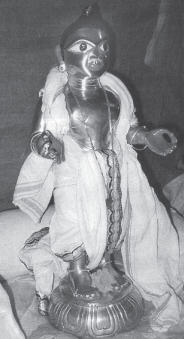
The next morning as we prepared to leave, I went to the main temple at Kheturi for one last viewing of the deities. The pujari was worshiping the salagrama-silas, and I was surprised to see him simply throw some water over Them, dry Them quickly, and place Them back on the al tar. It was a simple worship at best. He didn't massage Them in oil, which is customary, or even offer sandalwood paste or Tulasi leaves. When I saw the small fruit plate he offered Them, I became disappointed. When the superintendent of the temple appeared, I mentioned the seemingly poor standard of worship.
He hung his head and said, "It's true what you say. I've tried to impress this on the priests for years, but they don't seem to care."
I thought, "These are such important deities, a part of the pastimes of Narottama dasa Thakura. They deserve more than this."
I decided to take a chance.
"Narottama dasa Thakura is a great source of inspiration for me," I said. "He's a great preacher and a deeply realized devotee. He's one of my heroes. I often think of him while spreading his message in Western countries."
Pausing for a moment and praying for mercy, I then said, "Would you consider giving me one of those salagramas! I'll take good care of Him, offering Him opulent worship. And He'll be part of Lord Caitanya's movement in the West, inspiring many devotees."
I was stunned by his reply.
"I've been observing your group closely," he said. "I can see that you are sincere Vaisnavas and that you all have deep affection for Narottama dasa Thakura. So take any salagrama you want. Just indicate to the piijari which one you desire."
I had already chosen the principal salagrama on the altar. He was the biggest one, exquisitely beautiful and as smooth as glass.
"I'll take Him," I said, motioning with my head {not my finger, which is considered impolite in Vedic etiquette}.
The super intendent instructed the pujari, who took the salagrama off the altar without any apparent emotion . He quickly put Him in my hand. I stood there, my hand trembling, trying to fathom the mercy I had received.
When I went back to my room to collect my belongings for our departure, I showed the deity to Radhanatha Swami, who was struck with wonder.
"He's so majestic!" he said.
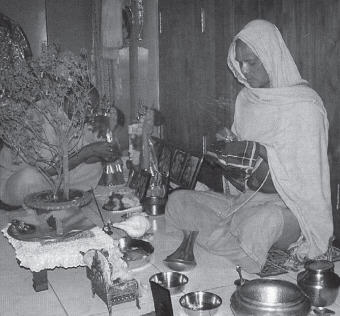
Sadly, we then left Kheturi, the holy abode of Narottama dasa Thakura's pastimes. While clutching the precious gift to my heart, I considered that the good fortune of Kheturi received by our small group of pilgrims would now go out to many Vaisnavas around the world.
We visited several other holy sites in the following days, such as those of stalwan associates of Lord Caitanya like Pundarika Vidyanidhi, Vasudeva Datta, Mukunda Datta, and Murad Gupta. We even visited the ancestral home of Lord Caitanya's father, Jagannatha Misra, an ancient array of stone buildings in the jungle in northern Bangladesh. But our experiences in Kheturi left the greatest impression upon me. After Kheturi I hankered to get back to my services in ) the West. In more ways than one, I had received special mercy, and I wamed to share it with others.
I didn't have long to wait. At the Dhaka airport, while in a lounge preparing to board my flight out of the country, a Muslim holy man approached me. As a security measure, I was dressed in Western clothes and sported a twoweek beard. Many Muslims assumed I was one of them, and had been respectfully addressing me with the greeting"Salaam alaiktim." This particular man pointed to my bottle of special water and said in broken English, "Allah hu akbar! I'm very dry. Very thirsty. Please, water."
I froze. He wamed to drink from my bottle of water from the Padmavati River where Narottama dasa Tha:kura had received prema. Every drop in that bottle was sacred. It was capable of giving more than liberation; it could give love of God. But he thought it was just an ordinary boule of water. I hesitated for a moment, and several Muslim men looked at me.
Obviously, you don't refuse a Muslim holy man's request fo r a simple drink of water. So I handed him the bottle, and he proceeded to drink with gusto. I watched in shock as he guzzled more than half the botde.
He then turned to me and said, "Allah has been very kind to me today!"
"Yes, indeed He has," I replied with a smile.
I thought , "Even before leaving Bangladesh I'm sharing the good fortune of my pilgrimage with others. Indeed, this must be the perfection of visiting a holy place."
His Holiness Indradyumna Swami travels around the world teaching Krsna consciousness. In Poland, each summer he oversees dozens of festivals. Since 1990, these festivals have introduced hundreds of thousands of people to Krsna.
Adapted from Diary of a Travelling Preacher, Volume 5, Chapter 14. To receive chapters bye-mail as they come out regularly, visit www.travelling-preacher.com
To know more about Indradyumna Swami, visit www.indradyumnaswami.com
